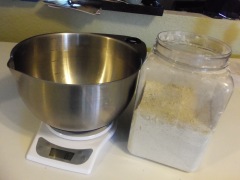 Did you know that flour can go bad? Whole grain flours are especially at risk, as they contain more natural oils and fats that can become rancid. And any flour is at risk of getting small bugs in it, as it is impossible to completely remove the insect eggs from the flour. Ew. You already know that it’s cheaper to buy flour in bulk, and if you’re making your own gluten-free flour mix, you’ll end up with several pounds each of a bunch of different flours. (I counted one time and discovered that I had eleven different kinds of flour in my house at one time. I may have an obsession with collecting gluten-free flours.) That’s a lot of flour to use up, and the likelihood of it going bad in my house is pretty high. It’s no savings to buy in bulk if you have to throw half of it away due to an invasion of pantry moths.
Did you know that flour can go bad? Whole grain flours are especially at risk, as they contain more natural oils and fats that can become rancid. And any flour is at risk of getting small bugs in it, as it is impossible to completely remove the insect eggs from the flour. Ew. You already know that it’s cheaper to buy flour in bulk, and if you’re making your own gluten-free flour mix, you’ll end up with several pounds each of a bunch of different flours. (I counted one time and discovered that I had eleven different kinds of flour in my house at one time. I may have an obsession with collecting gluten-free flours.) That’s a lot of flour to use up, and the likelihood of it going bad in my house is pretty high. It’s no savings to buy in bulk if you have to throw half of it away due to an invasion of pantry moths.
The quick tip for this Tuesday is to freeze your flours. Yes, our favorite kitchen tool here at Food Allergies on Ice is the solution once again! Keeping the flour very cold helps to keep the oils from becoming rancid, and keeps those tiny insect eggs from hatching. It’s also a dry, airtight space which helps the flour stay dry (obviously important!) and prevents bug invasions. (You know, in case the kids leave the back door open and a bunch of flies come in. Again.) Of course, you can use this trick to preserve gluten-containing flours as well.
One caveat to the freezer trick, though: make sure your flours come up to room temperature before baking with them or your recipes may not turn out as well. Here’s what I do: my bulk flours are in a box in the freezer. I pull out the box and mix up 2 kg of my All-Purpose GF flour mix at a time. That’s enough for a week or two of baking and it stays in an airtight container on my kitchen counter. The box of bulk flours is returned to the freezer for safe keeping until the next time.
Pretty simple, but this simple trick will help you save money and make tastier food. I call that a win!




